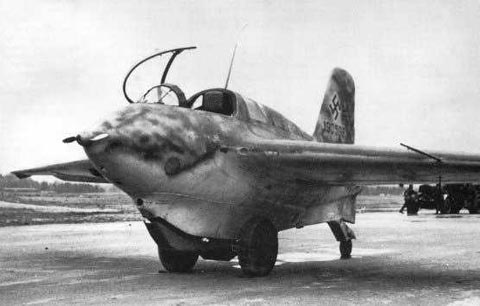Normally not: Extracting energy from the airflow produces drag, which must be overcome by added thrust. Since every form of energy conversion produces losses, more thrust energy must be added than can be gained from the airflow.
Only when the engines fail and the generators stop running does it make sense to extract energy from the airflow. In airplanes there are two applications which are driven by "wind energy":
- Older airplanes use gyros for the artificial horizon which are powered by ram air. This way the gyros work even after an engine failure.
- Jets use Ram Air Turbines (RAT), propeller-driven generators which are moved into the airflow when all other means of generating electricity and hydraulic power have failed. Note that this is done in unpowered flight and increases the sink rate.

Deployed RAT (picture source)
Rocket-powered airplanes have no easy way to generate electricity, so the Me-163 B used a small windmill at the tip of the fuselage to drive a generator.

Me-163 B (picture source)
EDIT:
With your question's new focus on electric propulsion the answer will become different. Now you most likely will have propellers which are powered by electric motors. During landing, those could run inverted and charge a battery, which will most likely be empty by the time the aircraft lands. This can be done during final approach until the end of the runout after touchdown. It can be expected that any electric airplane will have a high L/D, so deploying speed brakes to allow for a steeper approach makes sense.
I would be surprised if an additional device would be economical, however. This recharging must be done by the regular propulsion system, or it would add dead weight during most of the flight.
You asked for formulas, but all I can provide here are some back-of-the-envelope calculations. First, it must be said that variable-pitch propellers will be lousy as windmills, because their camber and twist are wrong for windmilling mode. I would expect that their efficiency is around 30%, which means that only 30% of the energy extracted by drag will be converted into mechanical energy which drives the electric motor.
Next, running an electric motor as a generator will again require compromises. Good motors make poor generators, and re-wiring the motor for better generator performance will degrade its efficiency in normal use. You will quickly lose more than you gain from the short flight phase when running the motor inverted makes sense.
Now let's assume that you keep your propulsion system at top efficiency (say, 90%) and accept that it will only convert 10% of the drag energy into electric energy. Let's also assume that your prospective solar airplane has an L/D of 30 which needs to be reduced to 10 for a practical approach. You do this from 1000 ft downwards and use the windmilling propeller also during the runout. Approach speed is $v$, mass is $m$ and the initial energy of the airplane is $305\cdot m\cdot 9.81 + \frac{m}{2} \cdot v^2$. Two thirds of the potential energy go into propeller drag, and to be generous we assume that 100% of the kinetic energy will also go into propeller drag, even though the braking force of the propellers at low speed is really lousy and needs support from wheel brakes.
Now it is important how fast your airplane flies, because this will shift the ratio between potential and kinetic energy. To keep things simple, I will relate both to the energy required for the next flight. 10% of the full kinetic energy will accelerate the aircraft to less than one third of its flight speed - after this, the remaining 91% of the energy to reach $v$ must be added by charging the batteries between flights.
The electric energy taken from the potential energy will help you climb to 60ft or sustain level flight at $v$ for a distance of 1800ft. At an L/D of 30 the airplane will fly a distance of 30,000ft without thrust, and by braking you will extract the energy to cover 20,000ft, which at 10% conversion efficiency (and 90% propulsion efficiency!) will carry you over just 1800 ft.


